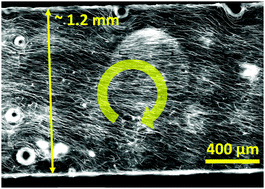Large-scale chirality in an active layer of microtubules and kinesin motor proteins†
Abstract
During the early developmental process of organisms, the formation of left-right laterality requires a subtle mechanism, as it is associated with other principal body axes. Any inherent chiral feature in an egg cell can in principal trigger this spontaneous breaking of chiral symmetry. Individual microtubules, major cytoskeletal filaments, are known as chiral objects. However, to date there lacks convincing evidence of a hierarchical connection of the molecular nature of microtubules to large-scale chirality, particularly at the length scale of an entire cell. Here we assemble an in vitro active layer, consisting of microtubules and kinesin motor proteins, on a glass surface. Upon inclusion of methyl cellulose, the layered system exhibits a long-range active nematic phase, characterized by the global alignment of gliding MTs. This nematic order spans over the entire system size in the millimeter range and, remarkably, allows hidden collective chirality to emerge as counterclockwise global rotation of the active MT layer. The analysis based on our theoretical model suggests that the emerging global nematic order results from the local alignment of MTs, stabilized by methyl cellulose. It also suggests that the global rotation arises from the MTs’ intrinsic curvature, leading to preferential handedness. Given its flexibility, this layered in vitro cytoskeletal system enables the study of membranous protein behavior responsible for important cellular developmental processes.



 Please wait while we load your content...
Please wait while we load your content...